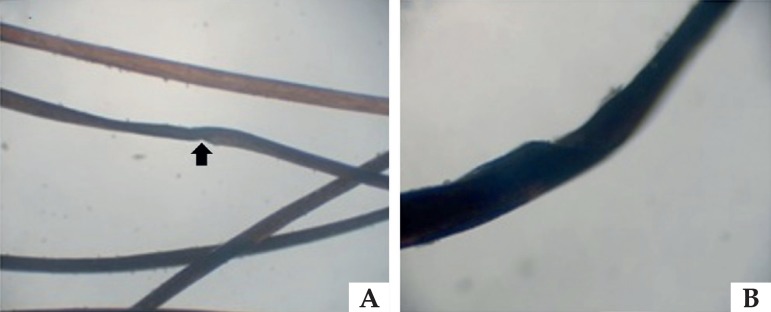Abstract
Ectodermal dysplasias are conditions that present primary defects in two or more tissues of ectodermal origin and can be classified as hypohidrotic and hidrotic. Hidrotic ectodermal dysplasia or Clouston syndrome is an autosomal dominant genodermatosis and appears as a triad of clinical findings: palmoplantar keratoderma, nail dystrophy, and hypotrichosis. The hair is sparse and brittle. The nails become thickened and dystrophic, which is an essential characteristic of the syndrome. The diagnosis is made based on clinical findings. This study reports a case of a patient who began with changes in hair, nails and palmoplantar keratoderma in early childhood.
Keywords: Palmoplantar keratoderma, Ectodermal dysplasia, Hypotrichosis
CASE REPORT
Female patient, 15 years of age, complained of changes in her toenails, plantar hyperkeratosis, and a history of dull and brittle hair since 2 years of age. According to the mother's report, the patient had never had a haircut and had never had other comorbidities. Moreover, the patient's parents were not consanguineous, and there were no other similar cases in the family.
Physical examination revealed nail plate dystrophy and subungual hyperkeratosis on the toenails, plantar hyperkeratosis, and absence of hair on the limbs. Hair was brittle, and the hair shaft was thick and irregular. The patient presented good hair density and showed no dental changes (Figure 1).
Figure 1.
A: Dull and brittle dry hair. B: Plantar keratoderma. C: Nail plate dystrophy
Trichogram revealed hair shafts with irregular helical twists (Figure 2). Skin biopsy of her right forearm revealed a single hair follicle in the dermis, but sebaceous and eccrine glands were preserved.
Figure 2.
Trichogram: A: Presence of irregular helical twist. B: Helical twist detail
Based on the skin and adnexal alterations presented above, the clinical condition was diagnosed as Clouston syndrome (hidrotic ectodermal dysplasia).
DISCUSSION
Ectodermal dysplasias (ED) are genodermatoses that display primary defects in two or more tissues of ectodermal origin, associated or not with defects in other tissues and organs.1,2 They may be classified as hypohidrotic or hidrotic.3
Hypohidrotic ED is characterized by fine, sparse or absent hair; absent or conoid teeth; and sharply decreased sweating, together with normal nails.4,5
Hidrotic ectodermal dysplasia (HED), or Clouston syndrome, is a rare dominant autosomal disease, caused by mutation in the GJB6 gene.6,7 Its major clinical findings include the triad palmoplantar keratoderma, nail dystrophy, and hypotrichosis.5,6,7
Palmoplantar keratoderma may develop during childhood and worsen with age, which is a common finding, though not universal.7 Nails usually become thicker and dystrophic over time, which is an essential characteristic of the syndrome.5-7 In approximately 30% of the affected individuals, nail dystrophy may be the only suggestive sign. Quite often, such alterations may be wrongly diagnosed as onychomycosis or pachyonychia congenita.5,7 Sweat glands, sebaceous glands, and teeth are normal, and these characteristics distinguish it from hypohidrotic ED.5,6,8
Hair is sparse and brittle, and total alopecia may ensue. Hair loss is usually gradual and may involve other areas, worsening after puberty.6,9 Athough nonespecific, a variety of hair shaft abnormalities may be found.5,9 A study published in 2012 reported trichorrhexis nodosa, trichoptilosis, pili bifurcati, different the hair shaft diameters, and damages to the cuticle in HED patients.9 In the present case the patient exhibited several helical shafts with irregular twists.
Diagnosis is based on clinical findings, since the simultaneous involvement of nails, hair, and palmoplantar region is highly suggestive.3,5 It is important to note that a negative family history does not rule out ED since sporadic cases have been reported.7
Dianosis may be delayed since healthcare professionals are often unaware of this syndrome.
Treatment basically consists of addressing clinical changes reported by the patient.7
Footnotes
Conflict of interest: None
Work conducted at the Dermatology Outpatient Clinic, Hospital Universitário Evangélico de Curitiba, Faculdade Evangélica do Paraná (HUEC-FEPAR), Curitiba PR, Brazil.
Financial support: none.
REFERENCES
- 1.Sugiura K, Teranishi M, Matsumoto Y, Akiyama M. Clouston syndrome with heterozygous GJB6 mutation p.Ala88Val and GJB2 variant p.Val27Ile revealing mild sensorineural hearing loss and photophobia. JAMA Dermatol. 2013;149:1350–1351. doi: 10.1001/jamadermatol.2013.4766. [DOI] [PubMed] [Google Scholar]
- 2.Freire-Maia N, Pinheiro M. Displasias ectodérmicas - Uma revisão clínico-genética. An Bras Dermatol. 1983;58:213–214. [Google Scholar]
- 3.Trídico LA, Antonio JR, Pozetti EMO, Rosa AMM, Antonio CR. Síndrome de Clouston: seguimento de um caso por 25 anos. An Bras Dermatol. 2015;90:896–898. [Google Scholar]
- 4.Chee SY, Wanga CH, Lina WD, Tsaia FJ. Ectodermal dysplasia (ED) syndrome. Biomedicine (Taipei) 2014;4:27–27. doi: 10.7603/s40681-014-0027-9. [DOI] [PMC free article] [PubMed] [Google Scholar]
- 5.Sybert VP, Zonana J. Bolognia JL, Jorizzo JL, Rapini RP. Dermatologia. Rio de Janeiro: Elsevier; 2011. Displasias ectodérmicas; pp. 874–880. [Google Scholar]
- 6.Kibar Z, Der Kaloustian VM, Brais B, Hani V, Fraser FC, Rouleau GA. The gene responsible for Clouston hidrotic ectodermal dysplasia maps to the pericentromeric region of chromosome 13q. Hum Mol Genet. 1996;5:543–547. doi: 10.1093/hmg/5.4.543. [DOI] [PubMed] [Google Scholar]
- 7.Der Kaloustian VM. Pagon RA, Adam MP, Ardinger HH, Wallace SE, Amemiya A, Bean LJH, et al. GeneReviews®. Seattle (WA): University of Washington, Seattle; 2005. - [2014 Jun 06]. Hidrotic Ectodermal Dysplasia 2. [Internet] Available from: http://www.ncbi.nlm.nih.gov/books/NBK1200. [Google Scholar]
- 8.Fabel J, Andrade Filho JSA, Leonardo MM, Pena GPM. Apresentação clínica da displasia ectodérmica hipoidrótica no récem-nascido: a propósito de um caso. An Bras Dermatol. 1999;74:375–378. [Google Scholar]
- 9.Hirano SA, Mason AR, Salkey K, Williams JV, Pariser DM. Light microscopic hair shaft analysis in ectodermal dysplasia syndromes. Pediatr Dermatol. 2012;29:414–420. doi: 10.1111/j.1525-1470.2011.01606.x. [DOI] [PubMed] [Google Scholar]




